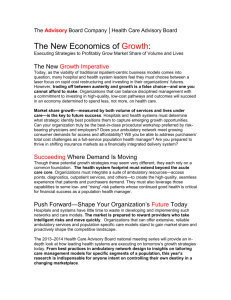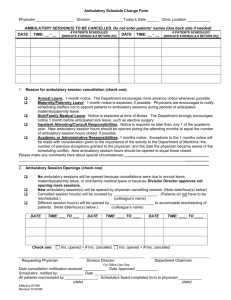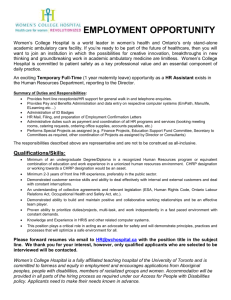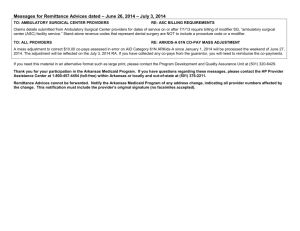Document 11057647
advertisement
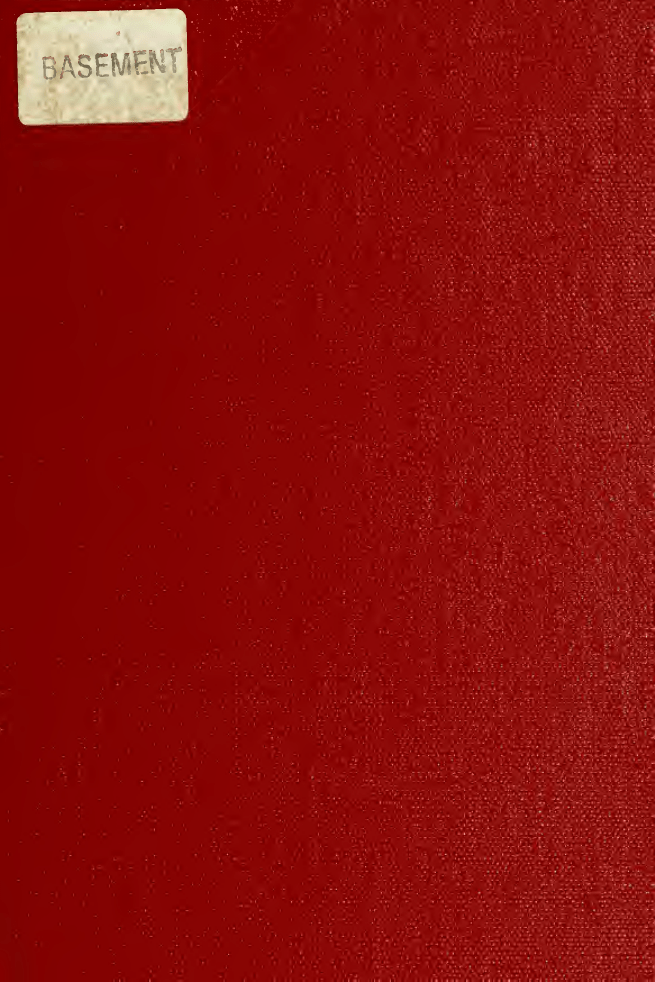
LIBRARY OF THE MASSACHUSETTS INSTITUTE OF TECHNOLOGY - 2^ 8 1975 ARIES,. ALFRED P. WORKING PAPER SLOAN SCHOOL OF MANAGEMENT ISSUES IN THE DESIGN OF M APPLIED BEHAVIORAL SCIENCE COURSE FOR HEALTH ADMINISTRATION STUDENTS^ by Mark S. Plovnick Ronald E. Fry Irwin M. Rubin May, 1975 WP // 789-75 MASSACHUSETTS TECHNOLOGY 50 MEMORIAL DRIVE CAMBRIDGE, MASSACHUSETTS 02139 INSTITUTE OF ^ [mass. INST. TECH. 1 MAY 2 DEV.'HY 2 UBRARY ISSUES IN THE DESIGN OF AN APPLIED BEHAVIORAL SCIENCE COURSE FOR HEALTH ADMINISTRATION STUDENTS* by Mark S. Plovnlck Ronald E. Fry Irwin M. Rubin May, 1975 WP // "7^ 789-75 The work described in this paper has been supported by a grant from the Robert Wood Johnson Foundation. This paper was presented at the Thirty-Fifth Annual Academy of Management Conference, New Orleans, August 1975. rtDzs M.I.T. LIBRARIES MAY 2 2 ^975 R-ECEIVED ISSUES TN THI- OF AN APPUTO REHAVIORAL Di;SIf;N SCIENCE COURSE FOR HEALTH ADMINISTRATION STUDENTS^ Mark S. PlovnJck, Alfred Ronald E. Fry, Alfred Irvln M. Rubin, Alfred P. P. P. Sloan School of Management, M.I T Sloan School of Management, M.I.T. Sloan School of Management, M.I.T. This paper deals with Issues In the design and evaluation of an experiment in the transfer of knowledge between two fields. The body of knowledge under Investigation is the applied behavioral sciences and the specific point of transfer is to managers of ambulatory health care delivery settings. Tlie experiment is designed to test two broad assumptions: 1. There exists within the applied behavioral sciences knowledge, skills, models, etc. (already known to be relevant In non-health care settings) which are relevant to many of the problems facing managers in health care delivery settings; 2. This body of knowledge can be adapted and transferred via educational interventions (e.g. course curricula, teaching notes, training designs) to graduate students of health care management. The Issues discussed Include questions of (1) what subjects/content; (2) what teaching technologies (e. g. lectures, exercises, courses, etc.) and (3) how to evaluate results. INTRODUCTION - THE NEED 7. existence of multiple professional disciplines in health care, often with conflicting goals. Against this general background, the authors have been working as management educators, researchers, and consultants in health care systems for several years In an attempt to transfer to these systems knowledge and skills from the applied behavioral sciences that have for many years been used very effectively In non-hcaltli care settings. These experiences have provided a first-hand view of both the kinds of skills that are necessary for managers in these settings, and some of tlie educational design Issues th.it must be addressed if these skills are to be effectively transferred fl]. The remainder of this paper will address some of these questions as they specifically relate to the design of a course in the management of ambulatory care settings for graduate students in health administration. WHY AMBULATORY CARE MANAGEMENT? One of the principle areas of concern in health care management has been tlie administration of ambulatory care fneilitleB. Clinics, out-patient departments, neighborhood lu'allh lenters, ele. are experiencing admlnhil r.illve d f f leu les dllferent from thorie loun.l In mor.' ra,! 1 lona lid-iiiU/il aettlngH, and for wlilrl, ther,. IH mile a.lmlnlHtral Ive experience and lew exlHtliig nnliitlnnN. In ad.lUlun. the problems and sklllri relevant to these setUngN are frequently overlooked in the curricula of sehoola of health adnilnlsl ration which olten focus mori> on hospital admlnlHtratli.n. Finally, because of this lack of attention In nehnnls ol health admlnlsl rat Ion and the lower pay and perceived slntua for administrators In these settings, ambulatory care often attracts less well educated and/or qualified administrators. Given these problems, and the increased significance of these settings in our changing national priorities, ambulatory care management was chosen as an Important focus for an educational intervention to improve the effectiveness of health care management. I Tliere Is ever-lncreuslng concerii today alioul tlif nature of our health care dlHtributlon syHl.nm. Willie on the one hand thi-rc are demands for Increased quality of care and for increased bccohbability to health care siTvlceH for all fchelona In our society, there are at the same time demandH for an end to the splrnling conts of sucli rare. Increasingly, health care organizations are rixngnlzlng the need for more effective management as one solution to these problems. However, there is a set of conditions that make effective health care management difficult, including: 1. 2. existence of health professionals untrained in management who "resist" administrative Inputs; a change in priorities toward ambulatory care settings which require now and different organization structures and processes; 3. *. 5. 6. I 1 1 1 1 WHO GETS THE COURSE? difficulty in attracting highly qualified administrators, particularly in ambulatory care; "crisis management" atmosphere reinforced by the "crisis care" model of medical cnre; unclear criteria of performance; dependence on outside funding rather than direct consumer support; '^72-*'74? The first strategy question to be decided concerned The work described in this paper has been supported by a grant from the Robert Wood Johnson Foundation. ^ what was the most appropriate target p<ipulcitlon for any educational intervention. The two main candipracticing managers In ambulatory dates were: (a) care settings, or (b) graduate students in health administration schools. The decision to focus on graduate students Involved several considerations: (1) they are In a learning mode and may be more receptive to new ideas; (2) they have more time than the harried administrators to devote to an educational process; (3) there was the potential of changing some of their attitudes toward ambulatory care and perhaps Influencing them to choose a career in this area; (4) they were more easily accessible in larger numbers and more likely to respond well to "teachers." The major point In favor of practicing managers was that they had the experience to understand and appreciate the kinds of managerial Issues that would be dealt with in the course, and they had an arena In which to practice any new knowledge or skills acquired in a course. While the decision was made to work with students, both of these latter considerations were important in the subsequent design of the graduate student course. COURSE OBJECTIVES The problems of health care managers discussed earlier and the decision to focus on a studentoriented course led to the following course objectives: 1. Knowledge To develop In students an awareness and understanding of the problems faced by managers of ambulatory health care facilities. Skills To develop in students skills in 2. diagnosing and solving the problems found in ambulatory health care facilities. To develop In students more Attitudes 3. positive attitudes concerning the manaKeablllty of ambulatory health care facilities. 4. Behavior Changes To Insure that students will use the techniques lonrned In thlH nurse when they enter their work settings; and to increase the number (or likelihood) of students choosing careers in ambulatory care settings. . . . . i APPLICATION OF A LEARNING THEORY Achieving these objectives depends upon solving a set of course design Issues with respect to course content (subject matter), teaching technolgoles (cases, lectures, exercises, etc.), positioning in the curriculum, etc. Decisions concerning these design Issues are often made in a non-systematic fashion based on convenience, tradition, materials available, etc. Experience has indicated, however. that to be effective those decisions need to be made based on two considerations: (1) what are the objectives themselves and how can their attainment and be facilitated by course design; (2) what are characteristics of the learners and how can the course design be most congruent with their styles of learning. Solutions to these questions were based on a theory of learning which suggests that L2j : learning is a four-stage cycle which Includes: 1. the concrete experiencing of events, situations, etc.; the observation of and reflection on these events; c. the forming of abstract conceptual constructs concerning these observations; the active implementation of these d. conceptual theories or constructs In everyday behavior, leading back to the concrete experiencing of events. a. b. people develop preferences for and/or differential abilities in one or more of these stages of the le.irnlng cycle. 2. The first There are two Implications to the above. is that the learning objectives of a course can employtechnology only be achieved If the learning ed utilizes the learning modes that are cnnr,ruent with the objectives. For example, it is difficult to teach skills (e.g. leading a group meeting) which are In modes 1 (concrete experience) and A (active experimentation) solely through lecture inputs which put students in modes 2 (reflection) and While all four 3 (abstract conceptualization). modes are necessary to effective learning, the active and concrete modes are particularly important in skill development. The second Implication of this learning theory is that different kinds of learners with different preferences or ahllltlea for different modes of learning m.iy require different cmpliasls In teaching I''(ir exumplc, an /il)ntra(t-ret loc t Ive tri'hnolonii-M. Hludent miiy be mort- comfortiiblo In n lecture format while a oncr#l<<-actl ve Mludi-nt m/ty prefer exercises, rolc-plnys, or dlmulalions. 1 The implication of all this Is that course design must be based on an understanding of the learning style requirements of both the course objectives, In this case the course objectand the learners. ives were of a highly applied, active, day-to-day management nature that stressed behavioral change Thus In this as well as conceptual understanding. course it was critical to include opportunities for students to practice newly learned skills (concrete -active) as well as the more traditional concern with understanding the rationale behind them In addition, previous (abstract-reflective). research with managers in Industry and health care they tend to have active, praghas indlrntcd that The implication here is matic learning styles Lz) that the course would have to be problem-oriented (applied and practical) and utilize exercises, simulations, and role plays (active) in addition to more traditional cases, lectures, and seminars. • Another different training intervention has been designed for use with practicing management groups from ambulatory care facilities. For more information on this course contact the authors at M.I.T. Sloan School of Management, SO Memorial Drive, Cambridge, Massachusetts 02139. . COURSE CONTENT In accordance with the course objectives (to achieve behavioral changes) and the styles of students (active pragmatic) the course content was organized primarily by problem and skill areas rather than by conceptual areas as most courses are organized. From the authors' experience, the following areas were Identified as most crucial: Structuring Organizations Managers in primary ambulatory care settings will, invariably, find that the structure of their organization does not support and reinforce required coordination between health deliverers. Most often, the existing structure reflects a traditional form of organization (adopted from more traditional delivery settings) which does not account for some unique and/or different demands which characterize primary, ambulatory care settings. Managers In these settings thus need the knowledge and skills which will enable them (a) to test the appropriateness of different organizational structures, (b) design new structures which are more appropriate, and (c) initiate the changes required to implement these new structures. Planning and Coal Setting Crisis management appears to be the rule father than the exception in most primary, ambulatory care settings. Developing the goals, objectives, and future -oriented thinking which would mitigate aRalnst a crisis orientation is particularly difficult In these settings because of the degree of uncertainty in funding, legislation, community relations, etc. The manager must be able to respond to and manage multiple and often conflicting demands (e.g. demands for quantity vs. quality care; community needs vs. funding requirements). These differences and conflicting priorities are an inherent aspect of the situation. Tliey will not disappear. Managers in these settings need tools and models to develop goal setting and planning procedures which minimize a crisis management orientation. Clarifying and Allocating Role ReNpunslhl I I iIph Considerable time and energy is wiisted In many primary, ambulatory care settings due to the absence of clearly defined and/or agreed-upon role responsibilities. Managers in these settings need to be able to define and clarify their own role responsibilities, to help others define their roles, and to negotiate and resolve differences which will develop. Furthermore, they need to recognize that this is not a "once and forever" procedure. Inherent in these settings appears to be the need to continuously test, up-date, and renegotiate appropriate role responsibilities. requires that a manager in these settings (a) be able to choose from among a range of decisionmaking modes and (b) have certain skills to cope with those situations which require involvement of others in decision-making and problem solving. Improving the Coordination Between Different Disciplines — Managing Change Implicit In all of tlie above Is the fact that the manager of a primary, ambulatory care setting needs ti) be a change agent. Knowledge, for example, about different organizational structures will be only minimally useful if tlie manager cannot initiate and manage the change process required to arrive at a new structure. The pressure for change will also be thrust upon the manager and his organization by forces beyond their control (e.g. environmental, societal, legislative forces). Managers in such settings thus need knowledge and skills to: (a) diagnose the need for a particular change; (b) test the organization's readiness; (c) develop strategies for change; (d) deal with resistance to change. Attitudes There are several underlying attitudes which are directly addressed In (he course. Many managers and students preparing to be managers seem to avoid careers In primary, ambulatory care settings. This avoidance Kii-niH to be based on Clio attitude: "You It'w can't get anything done in thene Hetclngs. Just coo hard to try to work In thoHe dettlnga." A HpeclMo Htib-elemenl of thlH general nccltude has to do with till- n/iture of the relationship between managers and physicians. Quite frequently, these When two parties avoid any HubstunClve contact. they do interact, the relationship is invariably strained. Often, neither the manager nor the physician has much empathy or understanding of the other's concerns and ways of thinking. The attitude and resulting behavior is one of competition and The course Is desavoidance versus collaboration. igned to help eliminate some of these attlcudinal obstacles. TEACHING TECHNOLOfTY Making More Effective Decisions Managers in these settings often recognize the Importance of involving others In the process of decision-making. On the other hand, they recognize the inefficiencies which result when "everything gets decided by consensus." Even in those decision making situations which do require the involvement of others, managers experience great difficulty in effectively working in such group situations. The effective coordination of primary, ambulatory care — The concept of coordinated care teamwork is a common general characteristic of all primary, ambulatory care settings. In many such settings, the concept becomes more formalized - teams are formally designated around Interdependent tasks. Any team, to function at optimal effectiveness, will need to engage in some kind of educational or developmental process. Managers in these settings will need the knowledge and skills not only to (a) set up and structure teams where appropriate, but (b) to provide for and support activities aimed at the development of more effectively functioning teams Classroom Design Because of the applied, skill-building emphasis of Che course, and because of the acclve/pragmatlc learning styles of the students, most of the subject sessions described provide opportunities for students to experience the problems being dealt with through exercises, simulations, etc., as well as opportunities to practice newly Icnrncd behaviors. More conceptual Inputs (lectures, readings, etc.) are provided where necessary to develop sufficient understanding of the problems being addressed to enable students to effectively diagnose and Intervene In their on-the-job situations. c. Behavioral Demonstrated use of knowledge and skills in actual work settings. The only short-term source of this data will be from students' preceptors in their summer experiences. In one experimental situation where the course is given simultaneously with the summer practlcum, preceptors will be asked to evaluate changes In student performance during the period of the course. In addition, these preceptors will be asked to compare the performance of these students with other students from previous summers who did not experience the experimental course. In both experimental situations preceptors will be asked to evaluate the students' final term papers describing their summer experience in terms of the accuracy of the diagnosis, and the usefulness of the recommendations made. . Positioning In the Curriculum Another design Issue concerns the positioning of a course within the two-year curriculum characteristic of most schools of health administration. To make the classroom work more relevant to students this course was designed to take advantage of the summer practlcum experience in a health care facility that is required of students In many health administration schools. In one experimental situation the course Is being conducted simultaneously with the practlcum experience to provide students with both clearer more concrete examples of the problems being addressed, and in areas in which they can "try out" any new skills, techniques, etc. that they learn. In a second experimental situation the course Is being offered subsequent to a summer practlcum experience. Differences between students' learning and application of new knowledge, skills, and attitudes in the two experimental situations will be noted. One assumption is that students who experience the course and the practlcum simultaneously will demonstrate greater ability to apply their newly learned knowledge and skills, although both groups will show Increased awareness and understanding of the problems being addressed In the course. A third experimental condition, not currently being studied would be to offer the course without any practlcum experience. Evaluation of Learning Hypotheses . This second aspect of evaluation Is an attempt to test some of the assumptions built into the course design. As described, a. Placement of Practlcu m. in one expi'rimental site the practlcum runs simultaneously with the course while in the other the practltum precedes the course. Comparisons between the two should indicate whether students In the first situation are better able to apply their newly learned skills. The learning styles of parCb. Styles Iclpiints will be compiired to see If the more active/pragmatic students learn more, arc more satisfied, and show greater attitude change in this course design than the other learning styles. In addition, students will be asked to Indicate which aspects of the course were most useful and their answers will be compared with their learning styles. 2. . Evaluation Evaluating the Impact of any classroom based experience is fraught with difficulties. In this case, the difficulty is enhanced by the desire to evaluate various aspects of the course design (e.g. placement of the practlcum experience) in addition to the overall course Impact. Therefore, there are two aspects to the evaluation. Overall Course Impact The course objectives stress changes in knowledge and skill levels, attitudes toward ambulatory care, and career plans. To this end attitudes toward ambulatory care and career plans are being measured by pre-course and post-course questionnaires. Knowledge and skill Increases are being moasured at three different levels: Subjective a. Perceptions by students of the quality and relevance of the course. Objective b. Demonstrated knowledge, skill, and attitude changes through chissroom exams, casework, and term p.iptrs. The term paper Is an Interest Int; evaluation vehicle as students In one oxpir Imental site will be asked to submit two papers describing, analyzing, and recommending solutions with respect to the problems they observed in their summer practlcum experience. One paper is due at the first formal class session following the practlcum, while the other is due at the course's conclusion. Comparisons of the two should Indicate Increases in diagnostic and problem-solving ability. 1. . . . The experimental courses are scheduled for the summer and fall of 1975. At that time initial results on the impact of the course will become available. The course design will be refined based on these results and then the final experiment will begin. This final experiment will test the hypothesis that a course of this kind can be successfully replicated, by existing faculty at schools of health administration, through the development of a detailed set of course materials. The widespread use of such a course, and the large scale development of skilled managers for health care systems 1* after all the ultimata objective. li] Plovnick, Mark S., Fry, Rubin, Irwin M. Ronald E. "Initiating Planned Change in Health Care Systems," Journal of Applied Behavioral Science Vol. 10 (1), 1974. [Zj "Individual Learning Styles and Kolb, David. the Learning Process," M.I.T. Sloan School of Management, Working Paper //535-71, 1971. , . ^08 1 U24 Lib-26-67 MAR 4 196'- '^^^''^^ TOflO ODq' ^^b 3 724 74 7^"^=^^ no.784- Irf-^*^^ 7 *BKS ''^^ N / 0002000" loao 000 3 755 'tl'ls no.785- 75 John R/A normative methodology Hauser, D«BKS 724731. TDflD 3 . . ' 0002065' QOD bSb I \^i\H EITS^ :H;ft-t43-w no.786- 75a Kobnn. Stephe/Larae scale direct OPtL DxBKS .Q00.2Q,5,5,4„ 726385 ,6? VOBD DOO bSb 27 3" V^ HD28.IVI414 no.787- 75 IMerton, Robert/Option pricing when und ?2474? f I D*8KS tt|t!rt!!!iiif DOO bMS bll TOflD 3 OOOl^ f •7^^ 3 TOflD 004 no.789-75 Mark/Issues 57b b71 HD28.IV1414 Plovnick. fc724742 3 D*BKS TOflD in the design of 00185823 DD2 720 Ofll ^yf
